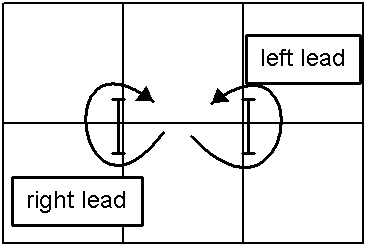Lead Leg
10 Oct 2004
The concept of a lead leg is most commonly associated with horse riding. But more Agility handlers need to become aware of their dog’s lead leg when planning and running their courses.
The concept is simple. A dog’s lead leg is the leg that initiates or “leads” the dog through a turn. In general a dog that starts turning to its right is going onto a right lead. A dog starting turning to its left is going onto a left lead. It should be noted that some dogs can “throw” themselves into a turn using their opposite leg if they are “forced” to by their handler. This is usually undesirable as it is awkward for the dog.
A good way to understand the lead leg concept is to walk quickly in a tight figure eight pattern. When making the change from circling in one direction to the other you are making a lead change. If you can do this in an unselfconscious manner you’ll find you always use the leg that will become the leg on the inside of the turn to initiate this turn. This is your lead leg. If you try to use the outside leg to initiate the turn you’ll find it awkward. Try this exercise while jogging or even running and you’ll really see how difficult it is to start the turn using the opposite lead.
If you repeat this exercise with your dog doing the running around two jump supports, carefully watch your dog or use a video camera. You’ll see your dog go from one lead to the other as they go through the turns just before the middle of the figure eight. This is diagrammed below:

I’ve videotaped Milo performing this exercise and posted it below at half speed, highlighting when he is on each lead leg. Milo was actually switching his lead leg as soon as I signaled the cross, at the far side of the jump standard away from the camera, so I had to really step in and exagerate the turn to make his lead change occur dramatically in front of the camera.
So why should Agility handlers care about their dog’s lead leg? Because where and when you change your dog’s lead leg directly controls their path on the course.
For example, in the sequence shown below if you don’t change the dog to a right lead before jump 2 the dog has to land and may need to take a stride in order to get on a right lead to turn to jump 3.

Alternately, if the handler pushes slightly left on the dog’s line after jump 1 and then turns the dog slightly to the right before jump 2, the dog will be on right lead before taking jump 2. This allows the dog to land on right lead and immediately turn to jump 3. This can result in a faster, tighter course.

There are some dogs that can change their lead in the air over a jump. But to do so you’ll often see the dog drop their former lead leg side’s legs as they twist their body. Depending on the dog’s height over the jump the dog can drop the bar.
I think it’s better to plan the dog’s lead changes to occur on the ground to give both the safest (from a clean run perspective) and fastest course time.
Start watching dogs run on Agility courses and you’ll start to see that where their lead change occurs effects how quickly and tightly they run the course.
Click this link to search the whole site for “Lead Leg”.
If you enjoyed this article won't you please:  Thanks!
Thanks!
